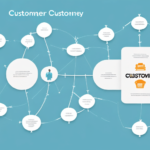Exploring the Relationship Between Customer Retention and Attrition
In today's highly competitive business landscape, retaining customers is one of the biggest challenges that companies face. The importance of customer retention cannot be overstated, as retaining existing customers is more cost-effective than acquiring new ones. According to a Harvard Business Review study, increasing customer retention rates by 5% can increase profits by 25% to 95%. This article explores the relationship between customer retention and attrition, understanding the factors that contribute to it, and strategies to enhance retention.
The Importance of Customer Retention in Business
Customer retention is critical to the success of any business. Research shows that it costs five times more to acquire a new customer than to retain an existing one (Bain & Company). Additionally, loyal customers tend to spend more money over time, provide valuable feedback, and often refer new customers to the brand. Therefore, a robust customer retention strategy can lead to:
- Increased revenue
- Reduced marketing costs
- Improved customer satisfaction levels
One effective way to retain customers is by providing exceptional customer service. When customers feel valued and appreciated, they are more likely to continue doing business with a company. This can be achieved by:
- Training employees to be friendly, knowledgeable, and responsive to customer needs
- Offering personalized experiences, such as customized recommendations or exclusive discounts
Another important aspect of customer retention is maintaining a strong online presence. In today's digital age, customers expect to interact with brands online. This includes having a user-friendly website, active social media accounts, and prompt responses to customer inquiries. By providing a seamless online experience, businesses can improve customer satisfaction and increase the likelihood of repeat business.
Understanding the Factors that Contribute to Customer Attrition
Customer attrition, also known as customer churn, is the opposite of customer retention and occurs when customers stop doing business with a company. Understanding the causes of customer attrition is crucial to developing an effective retention strategy. Some of the primary factors that contribute to customer attrition include:
- Poor customer service
- Unmet expectations
- Lack of engagement
- Competitive pricing
- Lack of personalization
Customers want to feel valued and appreciated by the companies they do business with. When a company fails to personalize their interactions with customers, it can lead to a sense of indifference and ultimately, customer churn. Personalization can be achieved through targeted marketing campaigns, personalized product recommendations, and customized communication channels.
Strategies to Improve Customer Retention Rates
Enhancing Customer Service
To improve customer retention rates, companies can focus on several key strategies:
- Prioritize excellent customer service: Train employees to provide personalized and responsive support.
- Use data to segment customers: Personalize marketing campaigns to better target customer needs and preferences.
- Offer exclusive perks or loyalty programs: Incentivize customers to continue doing business with the brand.
- Collect and analyze customer feedback: Continuously improve products and services based on customer input.
Establishing a Strong Online Presence
Another effective strategy for improving customer retention rates is to establish a strong online presence. This can include:
- Creating engaging social media content
- Regularly updating the company website
- Providing online customer support
By making it easy for customers to interact with the brand online, companies can build stronger relationships and increase customer loyalty.
Role of Customer Service and Communication
Impact of Customer Service on Retention and Attrition
Customer service is a core component of customer retention and can significantly impact customer attrition rates. Customers expect a seamless and efficient service experience, and the way a company handles customer complaints or inquiries can determine if a customer stays loyal or seeks out competitors. It is vital for companies to prioritize customer service training and have a robust customer service team in place to cater to the customer's needs.
Moreover, customer service can also positively impact a company's reputation and brand image. Exceptional service encourages customers to share their positive experiences, leading to increased brand awareness and customer acquisition. Conversely, poor customer service can result in negative reviews and word-of-mouth, harming a company's reputation and deterring potential customers.
The Role of Communication
Effective communication is essential in retaining customers. Companies must:
- Communicate effectively with their customers
- Listen to customer feedback
- Respond promptly to inquiries or complaints
Additionally, marketers must tailor their messages to customer needs and preferences and use various communication channels to reach out effectively. Regular communication helps build loyalty and trust, reducing the likelihood of customers switching to competitors.
Leveraging Data and Technology for Retention
Analyzing Customer Data to Predict and Prevent Attrition
One way for companies to predict customer churn is by analyzing customer data. By monitoring specific metrics such as customer satisfaction rates, purchase history, and engagement levels, companies can proactively identify potential churn before it occurs. According to a Forbes article, predictive analytics can enhance retention efforts by enabling targeted interventions.
Demographic information is also crucial. By understanding the age, gender, location, and other relevant demographics of their customers, companies can tailor retention strategies to better meet the needs and preferences of different customer segments.
Implementing Loyalty Programs
Loyalty programs are an effective way to incentivize and reward customers for their loyalty to the brand. By offering exclusive perks or discounts, companies encourage customers to continue doing business with the brand. Additionally, loyalty programs can gather valuable customer data that can be used to personalize marketing campaigns and improve the overall customer experience.
The Role of Technology
Technology is a valuable tool for enhancing customer retention. For example:
- Customer Relationship Management (CRM) software: Allows businesses to store customer data, track purchase history, and analyze customer behavior.
- AI-powered chatbots: Provide 24/7 customer support and handle routine inquiries, allowing human representatives to focus on more complex issues.
Case Studies of Successful Customer Retention Strategies
Examining case studies of successful customer retention strategies can provide valuable insights for businesses. For example:
Amazon and Apple
Companies like Amazon and Apple prioritize customer service and personalization, offering exclusive services to loyal customers and developing a strong sense of brand loyalty.
Starbucks Rewards Program
Starbucks offers a rewards program that allows customers to earn points for every purchase, redeemable for free drinks or food items. This encourages continued purchases and fosters a sense of exclusivity and belonging among loyal customers.
Enhancing Customer Experience
Improving the overall customer experience by providing easy-to-use websites, fast and reliable shipping, and responsive customer service can significantly increase customer satisfaction and loyalty, leading to higher retention rates.
Measuring and Monitoring Customer Retention and Attrition Rates
To effectively monitor retention rates, companies can use various metrics such as:
- Churn rate: Percentage of customers who stop using a service during a specific time frame.
- Customer lifetime value (CLV): Total revenue a company can expect from a single customer account.
- Retention rate: Percentage of customers who continue to use a company's products or services over a given period.
It's essential to track these metrics over time to determine the effectiveness of retention tactics. Additionally, companies should analyze survey responses, customer feedback, and testimonials to gain insights and improve the customer experience.
Connection Between Brand Reputation and Customer Retention
A positive brand reputation is instrumental in retaining customers. Companies must prioritize reputation management, as negative experiences or poor customer service can damage a brand's reputation and drive away loyal customers. Building a strong brand identity, developing trust with customers, and maintaining a positive brand image through effective marketing campaigns are essential strategies.
Utilizing Social Media for Improved Customer Retention
Social media platforms offer unique opportunities to engage with customers in real-time. Companies can use social media to:
- Listen to customer feedback
- Answer inquiries
- Offer exclusive deals
- Build a sense of community around their brand
Furthermore, businesses can use social media analytics to monitor customer sentiment and improve their retention strategies.
Building Trust with Customers to Reduce Attrition
Building trust with customers is a crucial component of reducing attrition rates. Companies must:
- Uphold their promises
- Provide transparent communication
- Address customer complaints promptly
By fostering a sense of trust and loyalty, businesses can retain existing customers and attract new ones.
Developing a Comprehensive Customer Retention Strategy
Developing a successful customer retention strategy can be challenging, but it's essential for long-term business success. Key components include:
- Prioritizing excellent customer service
- Analyzing customer data
- Offering exclusive perks
- Leveraging technology
By implementing these strategies, companies can ensure customer loyalty, boost revenue, and strengthen their brand's reputation.
Overall, understanding the relationship between customer retention and attrition is critical to business success. By analyzing metrics, leveraging technology, building trust, and developing a comprehensive retention strategy, businesses can retain loyal customers while attracting new ones and driving long-term growth.




















